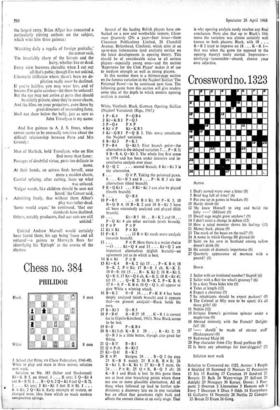Chess no. 384
PIIILIDOR
Black 6 men 8 men J. Scheel (1st Prize, us Chess Federation, 1946-48). White to play and mate in three moves; solution next week.
Solution to No. 383 (Schor and Neukomm): Kt - K B 5, no threat. 1 . . . R any; 2 Q - Kt 4 (set B - B 5). 1 B - Q 4; 2 Q -Kt 4 (set Q -R 7). 1 . . . Kt any; 2 Kt - Kt 3 (set R x B). 1 . . . K x Kt; 2 Q - Kt 6. Early example of mutate, or changed mate, idea from which so much modern composition springs. Several of the leading British players have em- barked on a new and worthwhile venture, Chess- man Quarterly (29s a year—four issues—from Chessman Publications Limited, 26 Churchill Avenue, Birkenhead, Cheshire), which aims at an up-to-date information (and analysis) service on the latest developments in opening theory. This should be of considerable value to all serious players—especially young ones—and the section `Repertoire for the Club Player' makes it of use to medium strength as well as strong players.
In this number there is a thirteen-page section on the famous variation in the Najdorf Sicilian 'The Poisoned Pawn'—to be continued next time. The following game from this section will give readers some idea of the depth to which modern opening analysis is carried.
White, Vitolinsh. Black, Gutman. Opening, Sicilian (Najdorf Variation). (Riga, 1967.) 1 P-K 4 P-QB4 2 Kt-KB3 P-Q3 3 P-Q4 PXP 4 Kt X P Kt-KB 3 S Kt - Q B 3 P-Q R 3. This move constitutes the Najdorf variation.
6 B-Kt5 P-K 3 7 P - B 4 Q - Kt 3. First branch point—the alternative is the delayed variation 7 ... P - R 3; 8 B - R 4, Q - Kt 3. The whole line first arose in 1954 and has been under intensive and in- conclusive analysis ever since.
8 Q - Q 2 . . . second branch; 8 Kt - Kt 3 is the alternative.
8 . . . Q X P. Taking the poisoned pawn.
8 . . . Kt -B 3 and 8 . P-K R 3 are the alternatives (third branch).
9 R -Q Kt 1 ... 9 Kt-Kt 3 can also be played (fourth branch).
9 . . . Q -R 6 10 P-B 5. . 10 B X Kt, 10 P-K 5, 10 B-Q B 4, 10 B-K 2 and 10 R -Kt 3 have all been extensively analysed and played (fifth branch).
10 . . . Kt-B3 10 ...B-K 2 and 10...
P - Q Kt 4 are other methods (sixth branch).
11 PXP PxP 12 Kt x Kt P X Kt 13 P -K 5 ... 13 B x Kt needs more analysis (seventh branch).
13 . . . P x P. Here there is a major choice —13 . . . Kt - Q 4 and 13 . . . Kt - Q 2 are important alternatives (eighth branch)—no agreement yet as to which is best.
14 B x Kt PXB 15 Kt-K4 B-K 2 (a) 15 ...P-K B 4; 16 B -K 2, P X Kt; 17 B -R 5 ch, K-K 2; 18 0 - 0; (b) 15 B- K Kt 2; 16 R -Kt 3, Q - R 5; 17 Kt- Q 6 ch, K -K 2; 18 R - Kt 41; (c) 15 Q-K 2; 16 B-K 2, P-K R 4; 17 0 - 0, P - K B 4; 18 Q - Q 1; all appear to give White a winning attack.
16 B-K 2 0-0 16 ... P-K R 4 has been deeply analysed (ninth branch) and it appears that—on present analysis!—Black holds his own.
17 R-Kt3 Q-R 5 18 P -B 4! R -B 2? 18 . . . K -R 1 is correct (as in Gipslis-Korchnoi, 1963). Now Black seems to be lost.
19 0 - 0 P -K B 4 20 R-Kt 3 ch K-R 1 20 . . . R-Kt 2; 21 Q - B 3 is a little better, though also good for White.
21 Q-B 3! B - B 1
22 Q x P ch B -Kt 2 23 Kt - Q 6! R -K 2
24 R x P1 Resigns. 24 . . . B - Q 2 (to stop
25 R- B 8 mate); 25 R X B, R X R; 26 R-Kt 5, R-K Kt 1; 27 Kt-B 7 mate. Or 24 . . . P x R; 25 Q x R, B - Q 5 ch; 26 K - R 1 and Black is lost. In this game there are at least nine branching points where there are one or more plausible alternatives. All of these when followed up lead to further sub- divisions; a discovery late on in one variation has an effect that penetrates right back and affects the correct choice at an early stage. That is why opening analysis rarely reaches any final conclusion. Note also that up to Black's 18th move the variation was almost certainly well known to both players; Black, with 18 - . .
R - B 2 tried to improve on 18 . K -R 1— that was when the game (as opposed to the opening theory) really started. Impressive- terrifying—lamentable—absurd; choose your own adjective.






































 Previous page
Previous page